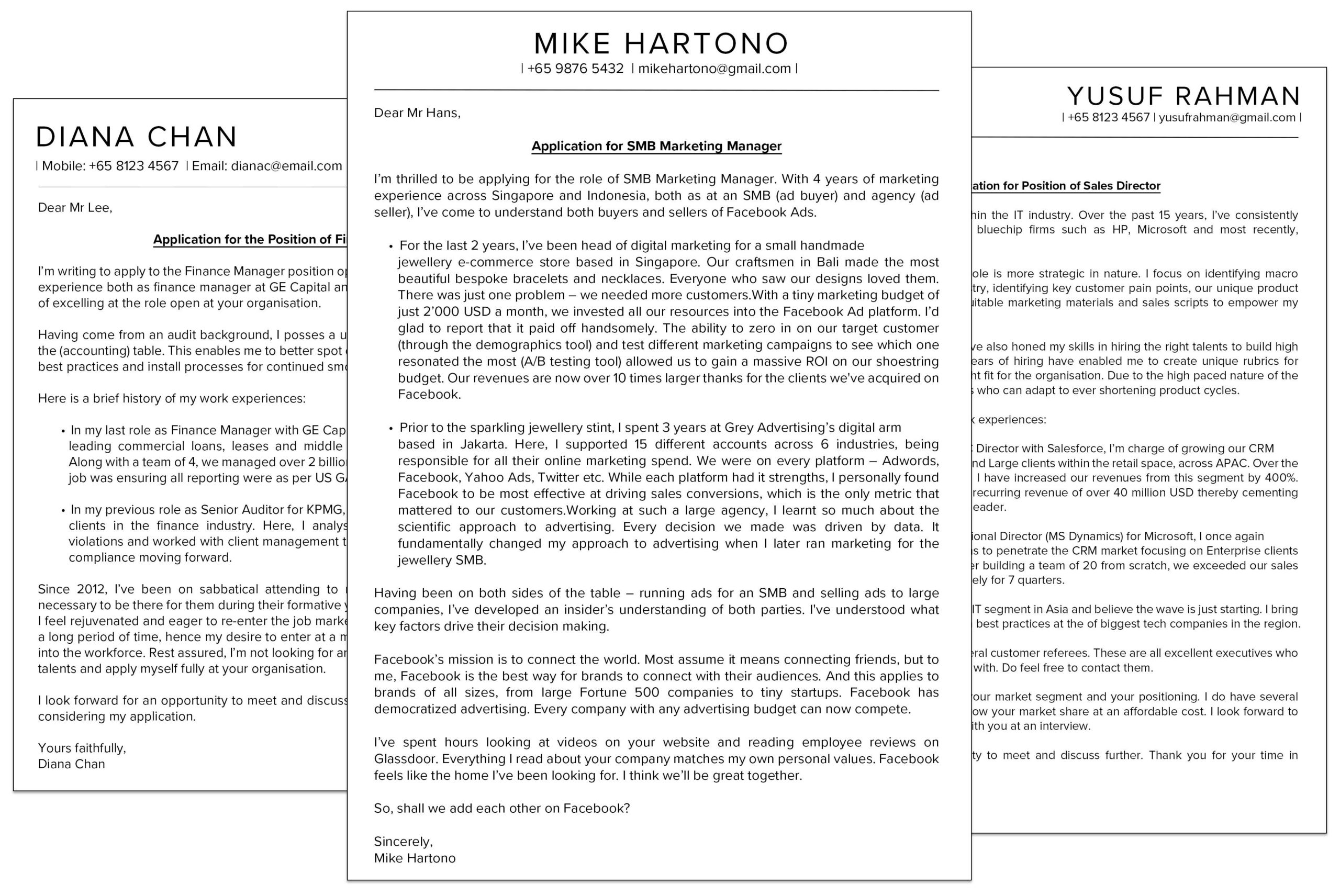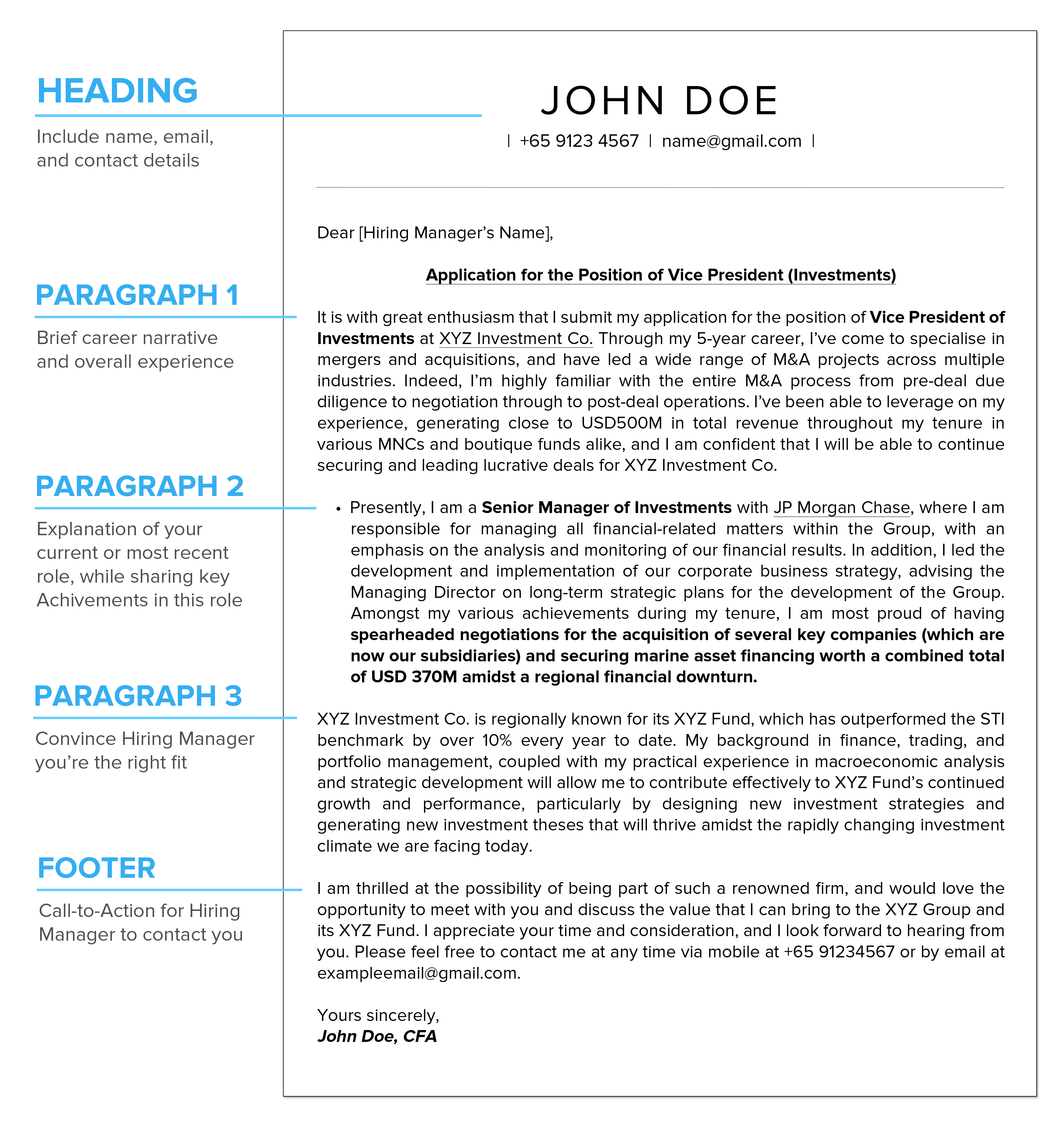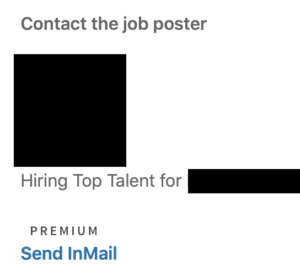Job Search Essentials
How to Write a Cover Letter in 2024 (英文求職信) | Your Ultimate Cover Letter Guide

“The job description says it’s optional to submit a cover letter. But do I really need to submit one? I’ve already said so much in my CV – that’s enough, right?”
Trust us, many jobseekers think this way. Unfortunately, they’re wrong.
Not submitting a cover letter is a lost opportunity to differentiate yourself.
Our advice?
Always submit a cover letter.

Why? While your CV or resume talks about what you’ve done previously, it doesn’t mention the value you can continue to bring to your new company.
This is what hiring managers REALLY care about.
Use the cover letter to talk about the value you can bring!
Now let’s dive right in. Here’s how to write a great cover letter:
- Introduction
- What is a Cover Letter?
- What’s the difference between Cover Letter and Resume or CV?
- Should I Customise my Cover Letter?
- How to Write a Cover Letter
- Cover Letter Examples
Introduction
Most people think the job selection process goes like this:

Here’s the problem though – every other job seeker is already doing this.
When Hiring Managers read a CV, they often think: “Yes this person is qualified, but so is everyone else who applied.”
So, how do you STAND OUT?
Easy.
By talking about what you can do for your new company:

But where can explain your specific future plans in the application?
In your cover letter!
This is the middle ground that so many people often miss out on.
A great cover letter is the missing jigsaw in your application. It’s your trojan horse to stand out from the crowd.
What is a Cover Letter?
It’s not just a piece of paper. Your cover letter is your golden ticket of opportunity!
You see, a cover letter helps you show companies just how awesome you are.
Simply put, an application letter is a one-page letter addressed directly to the hiring manager.
It grants you a chance to tell recruiters more about yourself on a personal level – something that cannot be done on your resume.
Unlike your CV or resume, which is a formal, factual document, you can afford to be creative with your cover letter format and content.
You can (and should) give your application a strong personal voice.
A cover letter echoes your voice directly to the recruiter, saying: “Hire me and your company can enjoy all of these results I bring!”
But, do keep it concise.
How long should a cover letter be? A maximum of 1 page. Strive to hit between 250 and 400 words.
Cover Letter vs Resume vs CV: What’s the Difference?
A cover letter is NOT an opportunity for you to copy and paste your resume or CV.
(We talk about the difference between a resume and CV here)
Think of the job hunting process as a two-piece puzzle.

Your CV is the first piece, while the Cover Letter is the second piece. Both pieces are essential for you to succeed in your job hunt!
You see, your CV tells potential employers your past career history: What you have done, and what you can do.
Meanwhile, your Cover Letter is the cherry on top. It’s the golden ticket that tantalises potential employers with the promise of future success if they hire you.
It tells potential employers your career narrative and your competitive advantage.
It sells you to potential employers: “Yes I’m very experienced and/or have the skills, but here’s a few ideas on how I’m going to apply that to benefit your company. So, hire me!”
Should I Customise my Cover Letter for Every Application?
A resounding YES!
We absolutely recommend that you write a custom cover letter for every company you apply for.
Every company has different business models and pain points, so it is imperative to tailor your cover letter to address them individually.
Now, how do you go about writing a great cover letter?
HOW TO WRITE A COVER LETTER
What to Include in Your Cover Letter
We’ll walk you through what to include in your job application letter step-by-step, starting from the very top.
First, let’s get a fuller picture by looking at a winning cover letter sample:

Begin with a professional Heading, with your name, email and contact details.
Next, use the Rule of 3 to guide the structure for the body of your letter. Divide your cover letter into 3 paragraphs:
Paragraph 1: Brief career narrative and overall experience
Purpose: Grab the hiring manager’s attention. Make this so good that he can’t help but finish reading it!
Paragraph 2: Explain your current or most recent role, and your achievements in this role
Purpose: Impress the hiring manager with your most recent achievements.
Paragraph 3: Convince Hiring Manager you’re the right fit
Purpose: Integrate how your present role of achievements can solve the new company’s pain points. This is the decision-maker; end your cover letter on an optimistic and promising note!
Finally, end the cover letter with a call-to-action for the Hiring Manager at the end.
Let us break each section of the cover letter down further.
You can download a free cover letter sample right here and follow us through this guide.
HOW TO START A COVER LETTER
Use a Professional and Appropriate Header
Include only your name, email and contact details.

Do:
- Keep your header short and sweet
- Follow the Rule of 3: Name, email, contact number
Don’t:
- Include your address
- Include your nationality (In fact, your nationality might be disadvantageous if you’re applying for a role outside of your current country!)
Address the Hiring Manager by Name
Examples include:
- Dear Mr. Chan,
- Dear Ms. Lee,
- Dear Mdm. Cheung,
- Dear [Hiring Manager’s Name],
How do you find out the hiring manager’s name?
Research using LinkedIn!
Type ‘HR Manager at [Company of your choice]’ into LinkedIn Search, and you’ll get plenty of results like the one below.

Some LinkedIn job listings even have the Hiring Manager’s name directly on the listing itself.

What if I really can’t find the HR Manager’s name?
If you really can’t find their name, address their department instead.
The trick is to customise your Cover Letter as closely to the role you are applying for as possible.
Examples include:
- Dear XXX Sales Team,
- Dear YYY Marketing Team,
However, never start your cover letter with ‘Dear Sir or Madam’! It comes off as highly impersonal, which defeats the purpose of a cover letter.
Remember, a cover letter is a golden ticket designed specially for that particular company!
Opening your letter with ‘Dear Sir or Madam’ implies you have not done any research at all, and you don’t even know if the hiring manager is male or female!
Do:
- Address Hiring Managers by their surnames
- Research on LinkedIn to find hiring managers
Don’t:
- Address Hiring Managers by their first names. They are not your friend!
- Use ‘Dear Sir or Madam’
THE BODY STRUCTURE
Paragraph 1: Brief Career Narrative and Overall Experience
Write a memorable, personable opening line
Cut over-formalities. Be personable instead.
Correct:
| I am delighted to submit my application for the position of Vice President of Investments at XYZ Investment Co. |
If you have an opportunity to present yourself directly to the hiring manager before he even sees your face, what first impression would you want to leave?
Nobody wants to read a long-winded opener consisting of only fluff. Keep it short and sweet.
Wrong:
| Thank you for very kindly extending the position of Vice President of Investments at XYZ Investment Co, of which I am extremely honoured to submit my application for. |
Of course, don’t be too informal too! The hiring manager is not your friend.
Wrong:
| Hey there! Please find my application for Vice Presidents of Investments at your company attached. |
Do:
- Be personable
- Demonstrate your enthusiasm for the role
Don’t:
- Be too formal
- Be pretentious
- Extend the first sentence into three or more lines
Hook from Line One
Intrigue the hiring manager from the first line! Show that you’re the perfect candidate:
| Through my 5-year career, I’ve come to specialise in mergers and acquisitions, and have led a wide range of M&A projects across multiple industries. Indeed, I’m highly familiar with the entire M&A process from pre-deal due diligence to negotiation through to post-deal operations. I’ve been able to leverage on my experience, generating close to USD500M in total revenue throughout my tenure in various MNCs and boutique funds alike, and I am confident that I will be able to continue securing and leading lucrative deals for XYZ Investment Co. |
In this example, the candidate dives right into his areas of expertise, which he takes particular care to align very closely with XYZ Investment Co.’s core businesses.
At the end of the paragraph, he already signals how his experience can add value to XYZ Investment Co. from day one. Remember, your cover letter should be about what value you can bring to your new company!
ResumeWriter Tip #1: After writing every sentence, put yourself in the Hiring Manager’s shoes and ask yourself “Does this point show how I can contribute to this new company?” If you cannot answer that from the Hiring Manager’s perspective, remove the sentence.
ResumeWriter Tip #2: Focus on addressing the new company’s pain points. If you know that a company is looking for talent to resolve specific pain points, write your cover letter to resolve these exact pain points and meet these needs. Structure the remainder of your cover letter answering why you are the perfect person to resolve these pain points. |
Do:
- Present yourself as somebody who others want to work with
- Keep your sentences concise and to the point
Don’t:
- Focus only on yourself! Include how you will add value to your new company too
- Extend your opening sentence into 3 or more lines
Paragraph 2: Elaborate Your Most Recent Achievements
Here is a sample middle paragraph:
| Presently, I am a Senior Manager of Investments with JP Morgan Chase, where I am responsible for managing all financial-related matters within the Group, with an emphasis on the analysis and monitoring of our financial results. In addition, I led the development and implementation of our corporate business strategy, advising the Managing Director on long-term strategic plans for the development of the Group. Amongst my various achievements during my tenure, I am most proud of having spearheaded negotiations for the acquisition of several key companies (which are now our subsidiaries) and securing marine asset financing worth a combined total of USD 370M amidst a regional financial downturn. |
Highlight only Relevant Experience
In the example above, he does not explain all of his responsibilities at JP Morgan Chase in detail. He drills down to only the key points.
Likewise, you probably had the opportunity to do a lot at your current job. But not every task will be relevant to your new role.
When writing your cover letter, highlight only experience and skillsets that are relevant to your new employer.
| ResumeWriter Tip: Identify the first requirement stated on the job description, or points that are similar and mentioned more than once. These are the most important functions for this role. Do weave that point into this paragraph (don’t copy and paste blindly!), and integrate it with your most significant achievements and existing job roles. |
Do:
- Include relevant experiences that are aligned with the new role
Don’t:
- Forget to embed target keywords into your experience!
Focus on Specific Achievements
In the example, this job applicant drills down to specific achievements.
In fact, take note how specific achievements are intentionally placed on the last line. This placement imprints the key achievement as the last thing on the Hiring Manager’s mind before he moves on to the next paragraph.
| ResumeWriter Tip: Put your key achievements on the last line of the middle paragraph for maximum impact. We do not recommend putting it on the first line – save that for an introductory sentence instead! |
Do:
- Explain and elaborate your Achievements
- Support your Achievements with Metrics
Don’t:
- Forget to align your Achievements with the new company’s pain points
- Speak too much about yourself only!
Use Target Keywords
As with your CV, always massage target keywords throughout your cover letter. Thoroughly examine the job posting and input relevant keywords into your cover letter. This reflects your acute attention to detail, leaving a very positive impression on the Hiring Manager that you really want the role.
As an example, the relevant target keywords for the candidate’s cover letter have been bolded below.
| Presently, I am a Senior Manager of Investments with JP Morgan Chase, where I am responsible for managing all financial-related matters within the Group, with an emphasis on the analysis and monitoring of our financial results. In addition, I led the development and implementation of our corporate business strategy, advising the Managing Director on long-term strategic plans for the development of the Group. Amongst my various achievements during my tenure, I am most proud of having spearheaded negotiations for the acquisition of several key companies (which are now our subsidiaries) and securing marine asset financing worth a combined total of USD 370M amidst a regional financial downturn. |
How do you know what target keywords are relevant?
By doing your research!
In order to know exactly what Hiring Managers are looking for, examine the job description.
Also, do look into the company’s core businesses and products. Then tailor your existing roles to this new role by inputting the target keywords uncovered from your research.
Do:
- Massage target keywords into your Achievements and roles
Don’t:
- Copy and paste target keywords directly into your cover letter
Include as many Relevant Numbers or Metrics as you can!
I admit, I’ve “stolen” this tactic from our Ultimate CV Guide.
But, nothing gives Hiring Managers more information than numbers.
Numbers add a sense of scale to your achievements.
For example:
As a general rule of thumb, the more numbers, the better.
But, bigger numbers do not always mean they are better.
Finally, numbers must be relevant to the new role!
Do:
- Include relevant metrics that help
- Ensure metrics are recent (preferably achieved in your current role)
Don’t:
- Include irrelevant metrics
- Fake your metrics!
HOW TO END A COVER LETTER
Paragraph 3: Convince the Hiring Manager You’re the Right Fit
Demonstrate Your Value-Add and Fit
Now, having shared your Achievements in the second paragraph, it’s time for you to write the final paragraph of your cover letter.
The final paragraph is your last chance to impress the Hiring Manager.
If you have one last chance, what would you do?
Would you continue telling them how awesome you are?
Most people would.
This is why most people don’t get the job.
You see, while this seems like it might be helpful for hiring managers, for them, it’s actually a red flag!
Remember: It’s not about what you’ve done, but what value you can continue to bring to your new company.
The first two paragraphs of your cover letter already tell Hiring Managers your awesome skills.
Repeating this in the last paragraph bores them. It wastes their time. It might even give them the wrong impression that you’re a showoff.
It recycles the original job hunting model that so many people use.

Instead, blow them out of the ballpark at the end by showing them just how you can deliver results for their company!
Here is a stellar example of how to end a cover letter.
| XYZ Investment Co. is regionally known for its XYZ Fund, which has outperformed the EWH benchmark by over 10% every year to date. My background in finance, trading, and portfolio management, coupled with my practical experience in macroeconomic analysis and strategic development will allow me to contribute effectively to XYZ Fund’s continued growth and performance, particularly by designing new investment strategies and generating new investment theses that will thrive amidst the rapidly changing investment climate we are facing today. |
Notice how the candidate starts this paragraph.
“XYZ Investment Co. is regionally known for its XYZ Fund, which has outperformed the EWH benchmark by over 10% every year to date.”
He begins his final paragraph by complimenting his new company. This informs the Hiring Manager two points:
- He has done his background research on our company (Strong sign of interest!)
- He admires our current results (Strong sign of interest!) and is willing to help us grow. (Value-add by him).
| ResumeWriter Tip: There is a fine line between complimenting and bootlicking! A genuine compliment out of admiration is authentic, and comes with an action: further suggestions or a desire to improve. Bootlicking is a compliment for compliment’s sake – an immediate turn-off for Hiring Managers. To differentiate between authentic compliments and bootlicking, continue reading below. |
This would pique the Hiring Manager’s interest: How would this candidate help add value to our company?
This is where the subsequent sentences come in:
“My background in finance, trading, and portfolio management, coupled with my practical experience in macroeconomic analysis and strategic development will allow me to contribute effectively to XYZ Fund’s continued growth and performance, particularly by designing new investment strategies and generating new investment theses that will thrive amidst the rapidly changing investment climate we are facing today.”
This answers the Hiring Manager’s question. He has a proven track record, and the perfect skill set and expertise to deliver on his words.
He even goes one step further by outlining specific actionable steps on how he would implement change if he is hired:
“Particularly by designing new investment strategies and generating new investment theses that will thrive”.
He’s extended his golden ticket, dangling it in front of the Hiring Manager.
The Hiring Manager would regret not biting that bait!
This final paragraph very clearly explains the middle box in the second model for job hunting:

Notice that his current company was not mentioned anywhere in the final paragraph?
Near the end of your cover letter, do not mention your existing or past companies anymore! Signal to the Hiring Manager that your future lies with their company.
In summary, when writing the final paragraph:
Do:
- Clearly explain how you can add value to the new company
- Explain how you can fit into the role
- Align your background and relevant skillsets as solutions to the new company’s pain points
Don’t:
- Only talk about yourself
- Mention your existing company (or past companies) at all!
Include a Decisive Call-to-Action
Now, having extended your bait, it would be extremely rude to leave the Hiring Manager hanging when they bite.
To end your cover letter, include a decisive call-to-action for the Hiring Manager.
This is how John does it:
| I am thrilled at the possibility of being part of such a renowned firm, and would love the opportunity to meet with you and discuss the value that I can bring to the XYZ Group and its XYZ Fund. I appreciate your time and consideration, and I look forward to hearing from you. Please feel free to contact me at any time via mobile at +852 1234 4567 or by email at exampleemail@gmail.com. |
He reiterates his enthusiasm to join this new company, and leaves his contact details for the Hiring Manager to reach out to him.
Do:
- Be courteous
- Provide your contact details only at the end (last sentence)
- Show your enthusiasm – end your cover letter with an optimistic note!
Don’t:
- Come off as desperate
- Threaten the Hiring Manager
Use the Right Formal Closing
Finally, close the cover letter professionally.

Cover Letter Examples: Cover Letter Samples and Templates
Congratulations, now you know how to write a cover letter like our team of expert resume writers! Try your hand at writing your own cover letter with these free cover letter samples and templates, which you can download and use.

Phew, it’s been a lot to take in, we know.
If you have further questions, or would like our career consultants to review and provide feedback on your CV, just fill in the form below for free CV feedback.
You’ll lose nothing, yet gain so much more!

